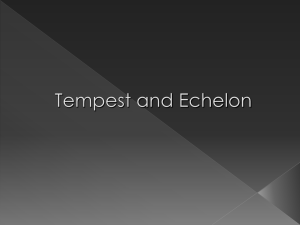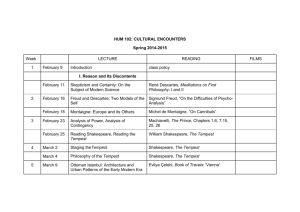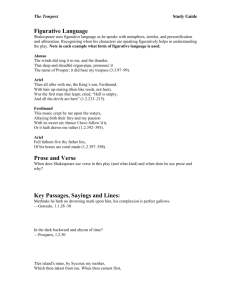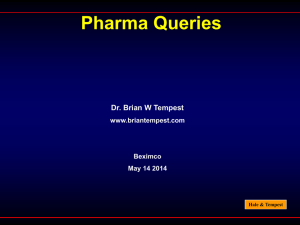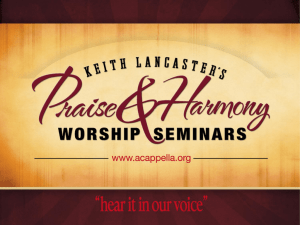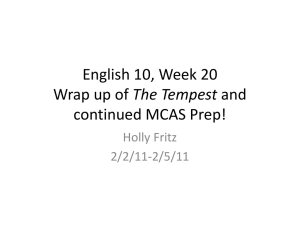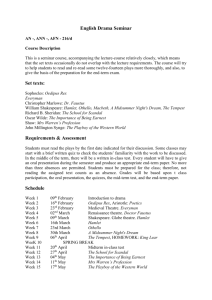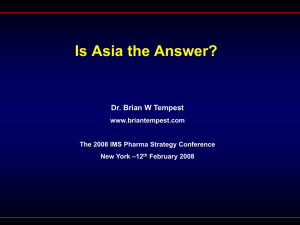Introduction - Medieval English genealogy
advertisement
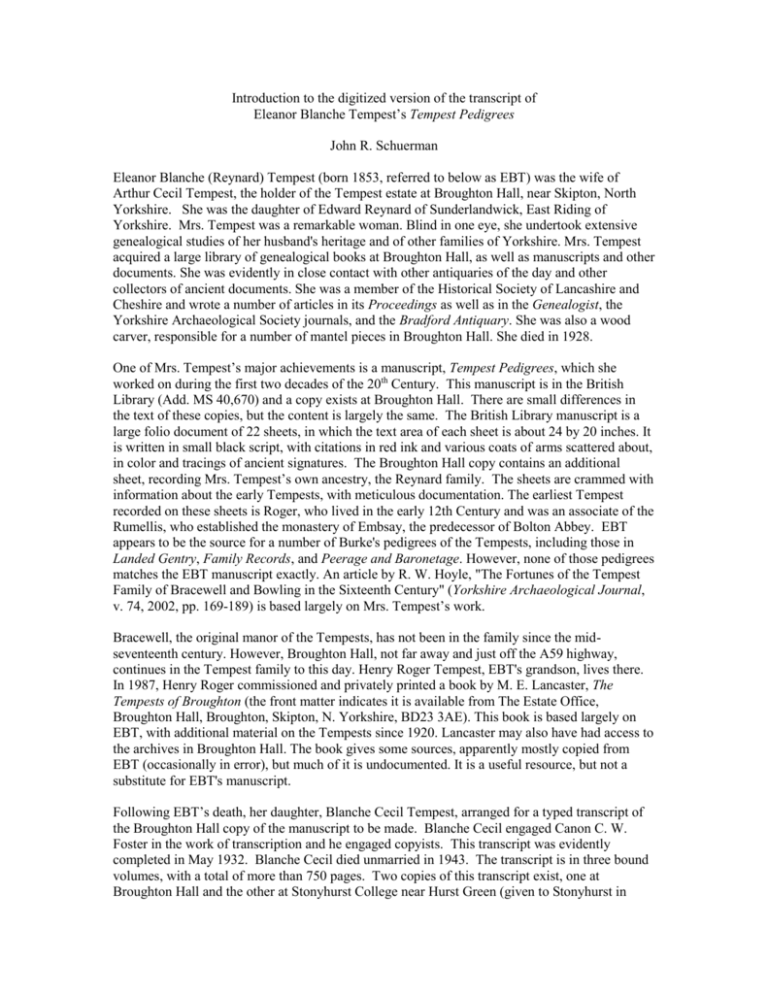
Introduction to the digitized version of the transcript of Eleanor Blanche Tempest’s Tempest Pedigrees John R. Schuerman Eleanor Blanche (Reynard) Tempest (born 1853, referred to below as EBT) was the wife of Arthur Cecil Tempest, the holder of the Tempest estate at Broughton Hall, near Skipton, North Yorkshire. She was the daughter of Edward Reynard of Sunderlandwick, East Riding of Yorkshire. Mrs. Tempest was a remarkable woman. Blind in one eye, she undertook extensive genealogical studies of her husband's heritage and of other families of Yorkshire. Mrs. Tempest acquired a large library of genealogical books at Broughton Hall, as well as manuscripts and other documents. She was evidently in close contact with other antiquaries of the day and other collectors of ancient documents. She was a member of the Historical Society of Lancashire and Cheshire and wrote a number of articles in its Proceedings as well as in the Genealogist, the Yorkshire Archaeological Society journals, and the Bradford Antiquary. She was also a wood carver, responsible for a number of mantel pieces in Broughton Hall. She died in 1928. One of Mrs. Tempest’s major achievements is a manuscript, Tempest Pedigrees, which she worked on during the first two decades of the 20th Century. This manuscript is in the British Library (Add. MS 40,670) and a copy exists at Broughton Hall. There are small differences in the text of these copies, but the content is largely the same. The British Library manuscript is a large folio document of 22 sheets, in which the text area of each sheet is about 24 by 20 inches. It is written in small black script, with citations in red ink and various coats of arms scattered about, in color and tracings of ancient signatures. The Broughton Hall copy contains an additional sheet, recording Mrs. Tempest’s own ancestry, the Reynard family. The sheets are crammed with information about the early Tempests, with meticulous documentation. The earliest Tempest recorded on these sheets is Roger, who lived in the early 12th Century and was an associate of the Rumellis, who established the monastery of Embsay, the predecessor of Bolton Abbey. EBT appears to be the source for a number of Burke's pedigrees of the Tempests, including those in Landed Gentry, Family Records, and Peerage and Baronetage. However, none of those pedigrees matches the EBT manuscript exactly. An article by R. W. Hoyle, "The Fortunes of the Tempest Family of Bracewell and Bowling in the Sixteenth Century" (Yorkshire Archaeological Journal, v. 74, 2002, pp. 169-189) is based largely on Mrs. Tempest’s work. Bracewell, the original manor of the Tempests, has not been in the family since the midseventeenth century. However, Broughton Hall, not far away and just off the A59 highway, continues in the Tempest family to this day. Henry Roger Tempest, EBT's grandson, lives there. In 1987, Henry Roger commissioned and privately printed a book by M. E. Lancaster, The Tempests of Broughton (the front matter indicates it is available from The Estate Office, Broughton Hall, Broughton, Skipton, N. Yorkshire, BD23 3AE). This book is based largely on EBT, with additional material on the Tempests since 1920. Lancaster may also have had access to the archives in Broughton Hall. The book gives some sources, apparently mostly copied from EBT (occasionally in error), but much of it is undocumented. It is a useful resource, but not a substitute for EBT's manuscript. Following EBT’s death, her daughter, Blanche Cecil Tempest, arranged for a typed transcript of the Broughton Hall copy of the manuscript to be made. Blanche Cecil engaged Canon C. W. Foster in the work of transcription and he engaged copyists. This transcript was evidently completed in May 1932. Blanche Cecil died unmarried in 1943. The transcript is in three bound volumes, with a total of more than 750 pages. Two copies of this transcript exist, one at Broughton Hall and the other at Stonyhurst College near Hurst Green (given to Stonyhurst in 1943). The Stonyhurst copy is the clearer, original type. Both have handwritten corrections. I do not know who did the handwritten corrections, it could have been Blanche Cecil, Foster, or a copyeditor. It is clear that they did not catch all the mistakes, but the result is remarkable nonetheless. The material that follows is a transcript of the Stonyhurst College transcript. My colleague and friend, Peter Worden of Blackburn (an alumnus of Stonyhurst), obtained loan of the Stonyhurst volumes from David Knight, the Stonyhurst archivist. Peter made clean photocopies of the volumes which he sent to me in Chicago. I scanned these copies into an optical character recognition (OCR) program (OmniPage) which produced a Microsoft Word version. As with all OCR programs, some mistakes were made in the conversion. I have proof read the results and corrected the mistakes as far as possible, but some errors in the transcription of the transcription no doubt remain. And, of course, it is likely that the first transcription of the original MS had errors. I have incorporated the handwritten corrections. I have noted what I believe are copyist errors with an italicized bracketed [sic] and I have corrected some obvious typographical errors without notice. Mrs. Tempest sometimes indicated errors in material she quoted with bracketed or parenthesized lower case [sic]. The transcription contains a large number of overstrikes. In some of these, it is difficult to judge what was actually meant and in some cases I have indicated my uncertainty thus: [?]. I have tried to collate the transcription with the original MS sheet on which the material appears with italicized sheet numbers at the beginning of the appropriate entries. The transcript was double spaced, I have used 1 ½ spacing. The transcription does not follow the original MS strictly. The transcriber endeavored to use standard style for narrative genealogy, showing all descendants under each person. EBT's MS is in chart form, so that each sheet is a continuation of previous sheets. The transcription has numbers of entries, both outline type numbers as in genealogical narratives and numbers in parentheses that run consecutively through the transcription. EBT’s manuscript does not have these numbers. The transcript runs the entries for wives into their husbands’ accounts, while the manuscript had separate entries for wives. There are some inconsistencies in the use of punctuation in what follows. EBT tended not to use periods at the end of sentences. The transcriber usually supplied those and I have supplied a few more. EBT used colons to indicate abbreviations and those have usually been retained. The use of apostrophes in possessive forms is inconsistent. In the transcription there occasionally appear opening quotes without corresponding closed quotes. I have treated these inconsistently, sometimes merely dropping the opening quote where it did not seem necessary, sometimes guessing at where the closed quote should appear, and in a few cases, keeping the open quote without supplying a closed quote. The transcript also records some events that were not included in E.B.T.’s MS, events that occurred after the completion of the MS (including E.B.T’s death). EBT sometimes raised questions about the material with phrases like “Query?” or simply a question mark. There is some repetition in the material, entries for wives and children sometimes repeat material from their husbands or fathers. EBT sometimes refers in the text to the drawings of coats of arms that she supplied on the manuscript so the following has references such as “see sketch.” The original MS had extensive documentation, in parentheses, in red ink. These have been retained in the transcript, in parentheses. EBT drew a considerable amount of this documentation from material at Broughton Hall. A large safe there contains a substantial collection of ancient deeds and other muniments. EBT made use of these materials in her work, so one finds in the following references such as “Broughton Deeds 2,” “Bro’ton 3,” etc. Some of these documents have been published, particularly in volume 1 of “Yorkshire Deeds” (v. 39 of the Yorkshire Archaeological Society Record Series). Other series of charters cited in the transcript and housed at Broughton Hall are the Kirkstall and Burnsall deeds. There are other references in the following that appear to be to documents at Broughton (e.g., references to boxes, etc.). There are a few parentheses containing only numbers, which I have not figured out, but which probably refer to boxes or folders at Broughton. There are also numbers in circles, which I have rendered in parentheses. The Stonyhurst transcript has tracings of signatures and copies of the heraldic shields (many in color) which Peter Worden scanned and which are included in the pages that follow, on the bottom of the pages. The Stonyhurst version also has a great deal of material interleaved, including pictures, letters, newspaper articles, and other printed material. I have included most of the pictures in the body of the following transcript, sometimes on unnumbered pages at the relevant points. As part of this introduction, I provide below transcripts of most of the written interleaved material. There are a few scraps of notes that I have not included, judging them to be of little value or repeating material in the main text. Mrs. Tempest used a number of abbreviations in her MS, particularly in the citations. Some of these follow: Bro’ton—Broughton B.M.—The British Museum, the library of which is now the British Library in London Chartu—Chartulary, a listing of the grants and charters to a particular church, abbey, etc. CRR—Calendar of Curia Regia Rolls (there are also the Coram Rege Rolls) CIPM—Calendar of Inquisitions Post Mortem CPR—Calendar of Patent Rolls CCR—Calendar of Close Rolls CFR—Calendar of Fine Rolls Dodsw.—Roger Dodsworth's manuscripts in the Bodleian Library at Oxford University. There are also copies of some of these in the Harleian MSS at the British Library. E.R.Y., W.R.Y, N.R.Y.—East, West, and North Riding of Yorkshire M.I.—Monumental inscription Mon: Angl:--Monasticon Anglicanum, an account by William Dugdale of the charters and grants made to churches, abbeys, etc. (Much of this is due to Roger Dodsworth.) O.S.P.—obiit sine prole, died without children O.S.P.M.—died without male issue P.C.C.—Perogative Court of Canterbury Par. Rec. or P.R.—Parish Records. Records of births, marriages, and deaths began to be kept by parishes in the mid-16th Century, but they are often spotty until the 17th C. Penes—not an abbreviation, but appears occasionally below. Latin for “held by” (usually referring to a manuscript). R.T.E. or Reg: Test: Ebor:—Registra Testamenta Eborencia, register of wills in Yorkshire, now held in the Borthwick Institute at the University of York. Some of these have been published. YASRS—Yorkshire Archaeological Society Record Series, Mrs. Tempest sometimes refers to this as Yorks: Rec: Soc: The Medieval Latin that E.B.T. quotes is usually quite abbreviated. Abbreviations are shown in the following with single quote marks at the end of words, although E.B.T. often used more elaborate marks for Latin abbreviations. One Latin abbreviation that often occurs in the following is “Dno” standing for “Dominus” or the female equivalent, meaning “Lord” or “Lady.” A table of contents of the original MS: Tempest of Bracewell, Waddington, Broughton, Bowling, etc. co York and Bealraper in Cosberton etc. co Lincoln, seven sheets Sheet 1 begins with Roger Sheet 2 begins with Sir John Tempest = Margaret Holland (for each of the sheets after the first, the person on the top has been described on a previous sheet), most of this sheet is about Sir Richard = (2) Isabella de Bourne d. of Sir Thomas de Bourne by Isabel d. & h. of Sir John le Gras of Studley and his descendents, mentions his brothers Sir John and Peter Sheet 3 also begins with Sir John Tempest = Margaret Holland but is concerned with his son Sir John Tempest = Katherine Sherburne and their descendents Sheet 4 begins with Sir Richard Tempest = Margaret Stainforth and concerns their descendents Sheet 5 Nicholas Tempest = Margaret Pilkington, and descendents Sheet 6 Sir Richard Tempest = Rosamund Bolling, and descendents Sheet 7 Nicholas Tempest = (1) Beatrice Bradford, and descendents Tempest of Broughton-in-Craven and Coleby co Linc., seven sheets Sheet I [note that this sheet contains similar material to that on previous sheets, though less extensive, particularly Bracewell sheet 1. A portion of this sheet concerns a pedigree of the Giliot family] Headed: Tempest of Broughton-in-Craven and Coleby c.: Lincoln. Sheet II William Tempest of Broughton-in-Craven Esq. died circa 1496 [Transcript: bef 1492] = 1st wife Joan dau of James Metcalfe Esq. Marr 1437 d. 1486 = 2nd wife Elizabeth, dau of Ric: Catterall of Little Mitton, co Lanc [no issue shown] Sheet III Roger Tempest of Broughton-in-Craven Esq. born circa 1470 [1464?], died 1537 = 1st wife Anne dau of Robert Carr, Esquire of the Body to King Henry VII, d. bef. 1581, m.c. 1499 = 2nd wife Elizabeth dau of William Huddleston of Millum, esq & widow of Edward Redman of Harewood, she died 1527, m.c. 1518 Sheet IV Sir Stephen Tempest of Broughton-in-Craven knight born 1553 died 1625 = 1st wife Anne dau of Edmund Eltofts of Farnell-in-Craven Esq = 2nd Katherine dau of Henry Lawson of Nesham co. Durham Esq. Sheet V Thomas Tempest Esquire born 1625 died 1697 = Anne dau & heir of Henry Scrope of Danby co York Esquire She died 1692 Sheet VI Stephen Tempest of Broughton in Craven Esquire born 14 Oct 1689, wed 16 April 1714 died 12 April 1771 = Elizabeth second daughter of Sir Henry Lawson of Braugh N.R. Yorks, Baronet, born 1693 died 19 Decenber 1732 Sheet 7 Stephen Tempest of Broughton in Craven, Rixton co Lanc & Coleby co Linc Esq born 1 May 1756, wed 1 May 1789, died 18 Nov 1824 = Elizabeth 2nd dau & coheir of Henry Blundell of Ince Blundell Esq. born Dec 1766, died 30 Ap: 1845 Tempest of Tong, co York, two sheets Sheet I Tempest of Tong co York Sheet II, Henry Tempest of Tong Esqre born Sept 1621, wed 22 March 1638, died 1659 = Mary daur of Nicholas Bushall of Bagdale Hall co York Esqre Tempest of Holmside, Stanley, etc., three sheets Sheet 1 Tempest of Holmside, Stanley, Stella, the Isle co Durham, Whaddon co. Cam., Cranbrook co Kent, dated 1 December 1917 Sheet 2 Robert Tempest of Holmside, co. Durham, Esq., dated 11 March 1914 Sheet 3 Thomas Tempest of Whaddon co. Cambridge, b. 1595, dated 26 November 1921 One sheet of various fragments of Tempest pedigrees, Tempest of Thornley co Durham [beginning 1567] The Reynards, one sheet [in Broughton Hall copy only] For a further examination of the early Tempests, see http://www.medievalgenealogy.org.uk/families/tempest/tempest1.shtml and http://www.medievalgenealogy.org.uk/families/tempest/early.shtml. A partial, no doubt incomplete, bibliography of EBT: Proceedings of the Historical Society of Lancashire and Cheshire: Mrs. Tempest was elected to membership in 1887 and somewhere along the line became a “life member.” Her name last appears as a member (a list is provided in each volume) in v. 80, 1928. She has several articles in the journal (none on the Tempests) as follows: v. 39 (n.s. 3, 1887) On descent of Mascys of Rixton pp. 59-159 v. 40 (n.s. 4, 1888) Schedule of deeds, chiefly relating to Warrington in muniment room at Broughton Hall, pp. 156-77 v. 41 (n.s. 5) On the chapels of the Mascys Foundation at Hollynfare and Warrington v. 42 (n.s. 6) The Anderton family v. 58 (n.s. 22, 1906), pp. 41-63 Some further notes on the Standish church, a follow-on to William Price on the Standish Church, v. 55-56, p. 259 Tempest Pedigrees, British Library Add. MS. 40670 “The Tempest Family at Bowling Hall,” Bradford Antiquary, new series vol. 1, 1896, pp. 491511. Pedigree of Tempest, of Bracewell, Broughton-in-Craven, Bowling, Tong, etc. (LDS film 702215); “The Tempest Family at Bowling Hall,” Genealogical Memoranda about Plumbe and Tempest, Privately Printed, 1898 (LDS film 1688786). "Broughton Hall and its Associations," Bradford Antiquary, v. 6, pp. 83-112, 150-178. “Four Tempest Bookplates and their Owners,” Miscellanea Genealogica et Heraldica, Sept. 1897. An article by R. W. Hoyle, “The Fortunes of the Tempest Family of Bracewell and Bowling in the Sixteenth Century” (Yorkshire Archaeological Journal, v. 74 (2002), pp. 169-189) is based largely on Mrs. Tempest’s work. Letter inserted at the beginning of the first volume: Oct. 21st 1943 Broughton Hall Skipton, Yorkshire Dear Rector. My sister-in-law Miss B.C. Tempest, before she died, expressed a wish that these 3 three volumes should be given to Stoneyhurst [sic] College. She gave us another copy some years ago, & I have found several clerical errors in dates, but apart from that I hope you will find it an interesting account of the Tempest family Yrs sincerely, Valerie A. Tempest On behalf of the late Miss Tempest’s sole executor, Stephen Tempest. The following was slipped into the covers of volume 1: The Chronicle. MAY, 1894. SIR RICHARD TEMPEST. NE of the most noteworthy of the "finds" during the recent restoration of Giggleswick Church was the stone effigy of a Knight which now lies near the organ. This was discovered in the "Tempest chapel," which forms the east end of the North Aisle (the "Stainford chapel" adjoining it on the west) ; and it is of this effigy that we give an illustration. [not here included] When we refer to Dodsworth's Notes on Giggleswick we find the following entry :- O "20th August, 1620, Giggleswicke Church. NORTH QUIRE WINDOW. Strykland. Sable, 3 Escallops, Ar.; Tempest. Ar. A bend between 6 martlets, sa. ; (Unknown) Az. goats' heads erased, or.: ‘Orate pro anima Richardi Tempest militis’ There is in this Quire a Monument of a man in armour with two wives, which they say was of one Tempest, of Stainforth in this parish, otherwise called ‘Knight Stainforth.’ ” As Whitaker in his History of Craven states that within comparatively modern times there were two recumbent effigies in the church (though he erroniously attributes them to the Stainford Family,) the Restoration Committee had great hopes that some traces of these effigies might be again brought to light, and with that care for the preservation of every ancient and interesting feature of the church which distinguished No. 2. 18 THE CHRONICLE all their proceedings, they ordered very careful excavations of the Stainford and Tempest Chantries to be made. Soon after the work commenced a large flat stone was found near the East Wall, and a number of willing workers, including the writer of this note, set to work to excavate it. The task was no light one, but before it had been raised to any considerable height it was found to be one of the eagerly looked-for effigies, buried face downwards. It was carefully raised up and found to be in a fairly perfect condition, except the hands. Further explorations brought to light the mutilated effigies of two other persons, but of these we must speak at another time. My own opinion is that Whitaker has been misinformed as to the period when these effigies were last visible, as, to me, it seems probable that they have been damaged and buried in the earth on one of the two occasions when the Common-wealth troops were at Giggleswick, and converted the church into barracks. A point that may be noted in connection with the members of the Tempest family who were buried in this Chantry is that the bones of the old Knights showed that they were of an exceptionally tall race ; and mingled with their remains were the bones of one of their chargers, the head of which had been buried alongside its departed master. This was a very interesting "find," and I put the fragments carefully on one side, intending to have them preserved, simply keeping an odd tooth that fell out of the jaw-bone. Next day I found to my annoyance that the workmen, who had very strict orders to re-inter, in huge graves to the north of the church, all bones that were found, had so conscienciously performed their duties that the remains of the Tempests and their charger were once more buried and the grave filled up. This interment of a favourite horse, or its head, with its late master, is a relic of very early times, and its discovery is of rare occurence. Saxton Church and Llanercost Priory are two of the best known instances in the north of England. THE CHRONICLE 19 It is hoped, therefore, that the following notes on the Sir Richard Tempest, who is commemorated by this effigy, may not be without interest, and I would express my acknowledgments to Mrs. Tempest, of Coleby Hall, for much of the information respecting the gallant old knight. This Richard was the eldest son and heir of Sir John Tempest, of Bracewell and Waddington, County York, and of Bealraper in Gosberkirk, County Lincoln, Knight, by his wife, Alice, daughter of Richard Sherburne, of Stonyhurst. He was born about 1419, and was knighted by Lord Clifford at the battle of Wakefield, 31st December, 146o. For his adherance to the Lancastrians he was attainted for treason at the parliament held at Westminster, in November, 1461, by King Edward IV. In 1461 he was admitted to the Guild of Corpus Christi, York. Sir Richard is named in his father's Will, 29th November, 1463, of which he was co-executor, and as such, sued various persons in Lincolnshire, at Michaelmas, 1466, for money due to the estate, being himself summoned in February, 1465-6, as his father's heir, to release Robert Johnson, of Kirton-in-Holland (Lincolnshire) whom his father, Sir John Tempest, when High Sheriff of Lincolnshire, had had in custody He made his peace with Edward IV, by assisting, with his two brothers, Nicholas and John, in the betrayal of King Henry VI, for which he was rewarded. In the Act of Resumption, 1476, King Edward excepted (inter alia) the annuity which he had heretofore granted out of the Duchy of Lancaster to Sir Richard Tempest, Knight, in consideration of the service he "didde to us in taking of our grete adversarie, Henry, late in dede and not of right, King of England." In June, 1437, Sir Richard had been bound, with his father, Sir John, and his great-uncle Roger Tempest, of Broughton, and others, in a recognizance of £400, to Sir Thomas Harrington, and the sum remained unpaid on Sir Thomas's death (at Wakefield, 31st December, 20 THE CHRONICLE 1460). The widow and executor sued Sir Richard Tempest, of Staynforth, Knight, with the other surties, for payment, in August 1462. All claims were paid up by March 1467-8 and Sir Richard was given his discharge. Sir Richard married, for his first wife, Sibill, daughter of Margaret Hoghton, the wife of Sir Richard Hoghton. In October, 1467, Sir Richard Tempest did his suit at the court of Skipton Castle, for the lands he held of that manor. In 1468 he held the parsonage or tithes of Giggleswick Church. He was High Sheriff of Lincolnshire in 1470, and in 1471 we find him witness to a charter relating to land in Carlton-in-Craven, with William Tempest (de Broghton) and Thomas Tempest (de Bracewell), Esq., and one at Settle on the 20th September, 1473. In 1474, Sir Richard Tempest, Knight, is returned as holding a moiety of Little Lever, in Lancashire, of Lord de-la Warr as of his manor of Manchester; and in September, 1476, Sir Richard Tempest de Staynforth, with William Tempest de Broghton, swore as to the Prior of Bolton's right to present to the rectory of Marton. He was one of the witnesses to the Deed of Feoffment dated 18th January, 1486-7, by which Henry, Lord Clifford, conveyed his estates in Yorkshire to trustees ; and in 1486, he paid to Robert Werdale, Prior of Finchale, sixty shillings fine for breaking an opening and improving a glass window at Giggleswick, probably the very window which Dodsworth described as above mentioned. Sir Richard married, secondly, Mabel, daughter of Walter Strickland, of Sizergh, county Westmoreland, who survived her husband. Administration of the goods of Sir Richard Tempest, of Staynforth, Knight, was granted at York, 28th February, 1488-9, to his widow, dame Mabel Tempest, to Sir Thomas Strickland, of Sizergh (dame Mabel's brother) and to Sir Thomas Tempest, of Bracewell (Sir Richard's brother). THE CHRONICLE: 21 it is almost a pity that, in accordance with ecclesiastical usage, the effigy of Sir Richard has been placed with the feet to the east, as the left side of the figure, showing the sword, &c., is the best. The site on which it is placed is naturally the most suitable one that could be got, being the nearest available spot to the old Tempest Chantry. The goat's head on which the head of the effigy rests refers probably to the coat of arms which Dodsworth mentions, as we have already seen, as being in the Tempest window, comprising "3 goats' heads erased." I think it very likely that these were the arms of the Stainford family. The figure has originally been coloured, and probably gilt in parts, and when first exhumed the colours survived fairly well. During its two years exposure to damp[?] and air, these have rapidly faded. May I humbly suggest to those in authority that the recolouring of the effigy, in accordance with the original tints, before they have quite disappeared, and the erection of the whole on an appropriate altar-tomb would be a sensible and worthy object of their attentions. MAY, 1894. T. B. [The following was slipped into the front cover of v. 3, it is evidently the effigy referenced above] The following is slipped into the covers of volume 2: Craven Herald, Aug. 21, 1936 THE TEMPESTS OF BROUGHTON Eventful Story of an Illustrious Family [FROM A SPECIAL CORRESPONDENT.] Among a score or so of Yorkshire recusants in 1735 of Catholic Squires and Peers, at that time in the County, the Scropes of Danby and the Tempests of Broughton are the only ones who retain both their Faith and their original estates In the male line. It may not be without Interest to sketch the Catholic life of the latter family and estates— even though we have to go back to the 12th Century. In 1120, Roger Tempest was a witness to the Charter by which Cecilia de Rumelli founded the Monastery of Augustinian Monks at Embsay, near Skipton, and when this great benefactress gave to the Canons of Embsay the Manor of Bolton, 1154-5, Roger Tempest was also a witness to this charter. He also attested to other grants of land to the monastic houses, and must have had some standing in the district. Ten generations later, in the direct male line, was Sir Richard Tempest, who gave half the Manor of Broughton, near Skipton, to his son Roger, and by his marriage with Catherine, daughter and heiress of Sir Piers Gilliat, Roger Tempest acquired the other half of the Manor of Broughton. In 1453, the Archbishop of York granted him a licence to have a private oratory within his Manor of Broughton. He and the parishioners of Broughton founded a chantry at the Parish Church. From Roger Tempest and Catherine Gillit is descended in the direct male line the present owner of Broughton, Brig.-General Roger Stephen Tempest, and his son, Stephen, is the 27th generation in direct descent from the Roger Tempest who witnessed Cecilia de Rumelli's grants of land. In 1542, Katherine, Dowager Duchess of Northumberland, bequeathed by will to her "good friend Stephen Tempest, of Broughton," various vestments and church plate. It was her grandson, Thomas, the seventh Earl, who was martyred in 1572. An uncle of the martyr, Ingram, had a daughter Isabel, who married Henry, son of the above Stephen Tempest. In his will, 1549, Stephen provides for "my chaplayne Sir Thomas," and also for the Chantry Priest at Broughton and "to my curate for forgotten or not dulie rekoned tithes. " Stephen's widow, Anne (Eltoftes), in her will, 155? wishes "to be buried according to custome of Holye Church," and leaves money to priests and horses, in the law which permitted no Catholic to own a horse of more than £5 in value. The Tempests saved many of their horses by putting them out in the care of their tenants and friends. Among the permits and licences still at Broughton, one allows Stephen Tempest to keep eight horses for coach and husbandry, and three saddle horses and 3 brood mares, "which are not to be seized as horses belonging to Papists." Another irksome law was that Papists had to have a licence to leave home beyond a certain distance, and even then they were limited as to time. Though licences and permits were given, searches in the Hall for arms took place in 1705. In 1723, over and above the other taxation, an Act was passed for granting an aid to His Majesty by laying a tax on Papists. Yet, in spite of the crushing fines and taxes, it is remarkable what was given to the poor. There are many entries in the accounts of gifts to "poor travellers," "poor in great necessity," "poor objects of pity," "the poor sick" and several "travelling slaves." That some place at Broughton was set apart for poor travellers is evident, as we read of a rug being bought "for, the poor bed." Hardly a week passes without charity being bestowed. Each festival of the Church found them remembering the poor in the neighbourhood— "against Christmas," "Against All Hallows," etc. And money is given, too, to "a Northumberland parson turned Catholic." Visiting Priests From 1649 we can trace a succession of chaplains or visiting priests. There is John Smith (aliases Wilkins and Thompson), who died in York Castle and is a Confessor of the Faith, second class. Mr. Barrow is the martyr Blessed William Harcourt, and the names of Blakeaye, Hesketh and Urmeston occur regularly till 1693-4. Father Placida, alias Brent, was arrested in Skipton in 1678, and one may surmise he was on his way to or from Broughton. When Mr. Thomas Burnett, S.J., came as chaplain in 1693-4, any priest convicted of discharging any of his priestly functions was liable to perpetual imprisonment, with a reward of £100 for such a conviction. For thirty-four years, till his death at Broughton. Father Burnett was the loved and trusted friend of the family, watching a large family of to the poor. Consternation The accession of Edward VI and the new religious regulations no doubt brought consternation at Broughton, and in the summer of 1548 the Tempests saw the King's surveyor seize to His Majesty's use "viij onces of plate parcell gilte, being a chalice from the late Chantry within the Parish of Broughton." (Chantry Certificate No. 1108.) In July, 1549, the Chancellor of the Exchequer directs Stephen Tempest "to viewe and enquyre into all the lands, plate, lead, bells, iron and other ornaments appertaining to various chapels, etc., to which His King's Majesty is entitled." (Aug. Off. Misc. Bks. fols. 151-153.) Stephen does not appear to have acted, for Anthony Dale later complains that he cannot obtain from Stephen Tempest the rent due, and that "there is in thandes of the Church Warden and parochianors of Broughton a stock of goodes belonging to lamp and light and obits." (Court of Aug. Pros. Bdle 32, No. 62 and Exch. Miss. Accts. 48.) From 1591 we find the Tempest family constantly in the Recusant Lists. As an example of the fines, Dame Katherine (Lawson), wife of Sir Stephen, was fined £40 for not attending the Parish Church, and later the fine is increased to £140 . In October, 1644, Stephen and his family, as Papists and Royalists, were exiled from Broughton and the estates were sequestered, but through the kind offices of friends and neighbours, in 1648 the Hall is again inhabited by a Catholic tenant, George Fell, who became steward, and it is from George Fell's estate accounts that we are able to trace the names of many of the priests who ministered at Broughton, besides getting glimpses of Catholic life in those days. Dame Tempest (Gascoigne) was charged with high treason and hatching Papist Plots, and with her kinsman Blessed Thomas Thiving, was imprisoned in York Gatehouse, but was acquitted the following year 1680. About 1684, Broughton Hall is several times mentioned as a place where Papists resorted. Under William III, the lot of Catholics was not a happy one. They had to pay not only a double land tax, but also a double poll tax. In the 18th Century, no Papists might keep a school, or otherwise educate the young, yet parents who sent their children for education abroad were liable to a fine of £100. Anyone who did not take the oath of allegiance to the Sovereign as head of the Church, or subscribe to a declaration against transsubstantiation, became incapable of inheriting or purchasing land, and the nearest Protestant heir could seize the estates. Popish Recusants were liable to be called by four Justices to renounce their errors or leave the kingdom. If they did not depart, or returned without the King's licence, they were liable to the penalty of death. Love of Horses There must have been a special sting for the Tempests, who always loved their [missing material] Tempests growing up, two of the sons becoming Jesuits and three of the girls becoming Benedictine nuns at Ghent, leaving their parents and home at the age of twelve, and not returning home for any holidays. In the estate accounts, Fr. Burnett's name is constantly altered, presumably an attempt to camouflage it from prying eyes. But through the pages we see how the Priest does many homely commissions for the family, no doubt carrying spiritual help at the same time. We find him buying red skins for covering chairs. At other times it is sugar, fish, cloth, books or oats. He fetches the daughters back from the Bar Convent at York in the coach—goes to Fontans (Fountains) on business for the family. He must have had an eye for a horse, too, for he went to Lancashire to buy a black mare, and another time he is buying a cart-horse, and another time a black dog in Bradford. Another chaplain, Mr. Pyett, evidently also acted as tutor, for Stephen makes a note, "gave Mr. Pyett a sorel horse for teaching my son Stephen." Mr. Fleetwood, another chaplain, bought both books and pictures, not necessarily religious books, for one is on Farriery. Most of the chaplains at Broughton were Jesuits, though there were a number of Benedictines and, at the time of the French Revolution, there were several emigre priests. Chapel Plate Among the chapel plate at Broughton there is a beautiful little silver-gilt chalice and paten 4 1/2 inches high, 1582; and another chalice and paten, larger, and with the emblems of the Passion engraved round the foot ; also a fine gilt Remonstrance, 1683, 22 inches in height. There is a vestment, now mounted in red velvet. with a record of having been repaired in 1684. The Chapel registers date only from 1757, and about that date there are the Confirmation and Easter lists, but the earliest Confirmation list is 1728, when 31 were confirmed. It is somewhat remarkable that no Irish names occur till 1793, a sponsor, one in each, 1801 and 1806, and infrequently till the 1830's. The Broughton Chapel has been a nursery for religious vocations, for several sons of the family have been Jesuits and Benedictines, and of the daughters, eight were Benedictines; in fact, between 1688 and 1729 there were six Benedictine nuns. The present Chapel is comparatively modern, having been added to the Hall in the middle of the 18th Century. The whereabouts of the original Chapel is uncertain, as the Hall had many alterations made to it in the 18th Century. Till the beginning of the century it was decorated in brilliant, if crude, colours. There are letters at the Hall from Pugin, who seems to have taken infinite pains to have the Crucifix and candlesticks made to his designs. Over the present, altar, under a large picture of the Crucifixtion, are the words in Latin, "May Christ reign," and they seem to sum up the story of this stronghold of the Roman Catholic faith. Slipped into the front cover of volume 3 is an article by E.B.T., “Four Tempest Bookplates and their Owners,” with the notation at the bottom of the first page: “Communicated to Miscellanea Genealogica et Heraldica, September, 1897, by Mrs. Tempest, of Broughton Hall.” This article is not reproduced here. Title page, in ornate calligraphy: Tempest Pedigrees/ Collected and compiled by Eleanor Blanche/ wife of/ Arthur Cecil Tempest/ of/ Broughton-in-Craven & Coleby, co. Lincoln/ 18781922 Unnumbered first page, in all caps: Introductory Note The original from which these pages of typescript are copied, was the work of about twenty years and was written by my mother, on large sheets 19in. x 25in., in her very small writing, - so small that she would get some twenty words in a space the size of a postage stamp. In the original sheets, my mother has copied seals in water paints very beautifully, and each generation has the arms emblazoned. She has also traced many signatures relative to the pedigree. Apart from the genealogical knowledge and information therein, these twenty six sheets of pedigree are a remarkable work of penmanship, particularly so, when one remembers that my mother only had the use of one eye. There are two volumes of these sheets of pedigree. One volume is at the British Museum and the other volume is left to me for my lifetime and after that it will go to the library at Broughton. There is one mistake that my mother made, which was using ordinary blue-black ink and even now not twenty years after writing, there are indications of the ink fading. When I decided to have the sheets copies I sought the advice of Canon C. W. Foster, of Timberland, Lincolnshire, for I knew my mother had great regard for his careful and accurate work. It has taken two and a half years to copy, and the copyist has had no easy task owing to the smallness of the writing. Each page has been carefully checked and examined. It is a misfortune that the typing was not done in my mother’s lifetime, but I am happy to be the means of its now being done. I hope that the pedigree will be transmitted to future generations of Tempests of Broughton; where it will, I trust, be regarded as a mark of my love and filial admiration of my mother. B. Cecil Tempest May 1932. In the Stonyhurst copy of the transcript there are inserted two handwritten letters, as follows: Timberland Vicarage Lincoln 21 May 1932 Dear Miss Tempest, Thank you very much for your cheque for £5 – the final payment for the copies of the Pedigrees. The work enabled me to keep my third clerk on my staff during the difficult days of the last twelve months. It is a satisfaction to think that Mrs. Tempest’s great work is put into a more permanent form. If anyone were to speak disparagingly of the immense labour that work entailed I should urge them to copy merely one sheet; and this would of course leave out all the research and compiling of the pedigrees. It is wonderful how she did it, when one thinks of her other activities. With kindest regards, Believe me, Yours sincerely, C.W. Foster 2nd letter: Allsprings, Gt Harwood. Blackburn 23 Apr. 32 Cecil I have recently finished the Yorkshire Recusants of 1735 & thought it might interest you to know that of all the score or so of Catholic Squires, Peers, etc. at that time in that County the Tempests are the only ones who retain both the Faith and their original estates in the male line. I had an idea that the Cholmeleys of Brandsley had the same distinction, but I heard this morning that both their Faith & Property have gone West. So you are the sole survivors. Yours ever, R. Trappes-Lomax [The following was pasted in facing p. 600, a handwritten note connects it to Dorothy, number 286 in the transcript. This is an error, it should be connected with Dorothy, number 826.] Times Jan. 12, 1933 WILLIAM BYRD A NEWLY DISCOVERED HOLOGRAPH FROM A CORRESPONDENT By a strange chance the writer recently secured a holograph document, signed “William Byrde," which should be of interest to lovers of Tudor music as bearing, if only remotely, upon the life of the great composer. It is a certificate dated October 17, 1581, that Dorothy Tempest whose husband, Michael Tempest, of Durham, was attainted for his share in the Northern Catholic Rebellion of 1570, but escaped to the Continent and entered the service of Philip II., was alive at that date. The British Museum authorities ascertained the fact of the attainder, and a holograph letter signed by William Byrde, and addressed "from the Court" to William Petre, an official of the Court of Exchequer, requesting him to pay to Dorothy Tempest an annuity which the Queen had granted her, was discovered at the Public Record Office. It bears the same date as the certificate, and evidently at some distant date both papers were filed together. The letter with the certificate addressed “To ye worshipfull and my verye good frend Mr. Petre on of ye officers of her Majies excheuquer at Westminster” is in these terms :— Mr. Peter. Meeting you lately in Aldersgat Street at Sir John Petre's house I moved you for the payment of the Annuitye dew unto Mris Dorothe Tempest at Michaellmas last past for ye quarter before passed. And then you promised me yt aboute a fortnight after yf I came unto you I shuld receyve yt for her bringyng a Certificat yf she is alyve so yt is sr yt my attendance heere at the Court is so requisite as I cannot have as yet any spare tyme to come to London for the receipt of the same. But this is most hartely to desyre you to accept of the Certificat under my hand as you have verye frendlye done heretofore. And to deliver unto ye partye yt shall Bring the same unto you wch I think wil be the gentlewoman herselfe, Suche money as is now dew. And you shall ever comande me in anything wherein may plesure you or any frend of yours while I lyve. And thus wth my verye hartye comendations I comit you to God. fro. the Courte this XVIIth of October 1581. Willm Byrde THE CERTIFICATE To all Christian people to whom this Certificat shall Come or to whom yt may appertayne tie Whereas it hathe plesed the Q. Ma of her great Clemencye and Goodness to geve unto Dorothe Tempest wyfe unto Michaell Tempest late attaynted. An Annuitye of XXl A yeare—for the Releavyng of her and her fyve Childerne havyng no other thyng left to Releeve and Mayntayne her and her fyve Childerne wth all But onlye ye sayde anuitye wch is to be payd quarterlys As by her Maties grant under her privye sceale. More at large dothe and may appeere. These are to Sertifye you yt the sayde Dorothe Tempest is Alyve and in Good healthe at the Makynge heereof. The XVIlth of October. Anno Regni Elizabethae Reginae XXIIImo 1581 Willm Byrde The document is written in elegant, artistic hand, and it is obviously not the work of a scrivener or lawyer, although it is in the legal phraseology of the period. The composer was probably fairly familiar with legal documents, for in the Calendar of State Papers under June 10, 1591 (an entry unrecorded by the late Mr. Barclay Squire and Dr Fellowes), one finds the Following :-Lord Admiral Howard to Dr. Aubrey, Mr. Herbert, and other Mesters of Requests. I have heretofore written you touching a cause between William Byrd, Her Majesty’s servant, complainent, and Basil Fetiplace, defendant, which being heard before you by two words left out of complainant's bill, he was driven to commence his suit again to his no small charge. Now as the cause, after many delays, is shortly appointed to heard, I earnestly desire you to show Byrde all lawful favour. As the only autographs of the composer hitherto known to exist are the two signatures to the will at Somerset House, it was not easy to verify.
